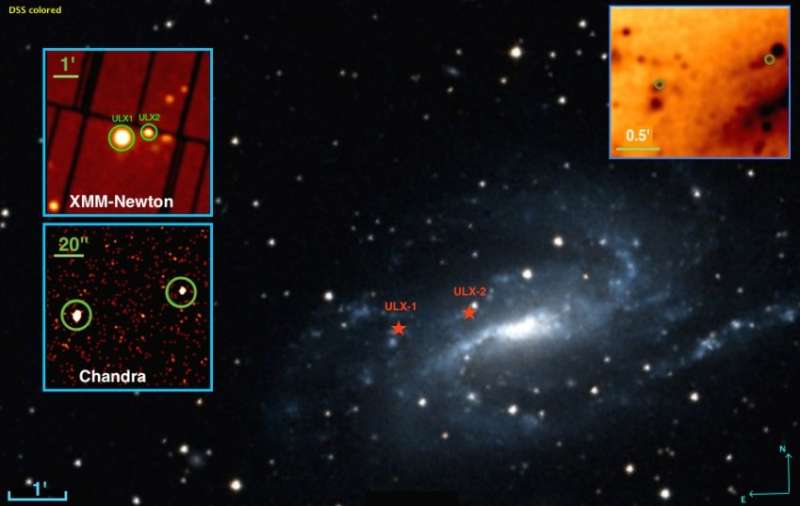July 11, 2018 report
Researchers investigate two ultraluminous X-ray sources in the galaxy NGC 925

European researchers have investigated two ultraluminous X-ray sources (ULXs) located in the barred spiral galaxy NGC 925. The study provides hints on the real nature of these two sources and could be helpful in improving our general understanding of ULXs. The research is detailed in a paper published June 29 on the arXiv pre-print server.
ULXs are point sources in the sky that are so bright in X-rays that each emits more radiation than a million suns emit at all wavelengths. They are less luminous than active galactic nuclei, but more consistently luminous than any known stellar process. Although numerous studies of ULXs have been conducted, the basic nature of these sources still remains unsolved.
Usually there is one ULX per galaxy in galaxies which host them, however some galaxies were found to contain many such sources. Located some 28 million light years away from the Earth, NGC 925 contains two ultraluminous X-ray sources designated NGC 925 ULX-1 and NGC 925 ULX-2. These two sources has been recently studied by a team of scientists led by Fabio Pintore of the Institute of Space Astrophysics and Cosmic Physics (ISAF) in Milan, Italy.
As part of the study the researchers analyzed observational data provided by ESA's XMM-Newton and NASA's Nuclear Spectroscopic Telescope Array (NuSTAR) spacecraft. The research also includes archival data obtained by NASA's Chandra X-ray space observatory.
"NGC 925 ULX-1 and ULX-2 are two ultraluminous X-ray sources in the galaxy NGC 925, at a distance of 8.5 Mpc. For the first time, we analyzed high quality, simultaneous XMM-Newton and NuSTAR data of both sources," the paper reads.
The researchers found that NGC 925 ULX-1 reached a peak luminosity up to 40 duodecillion erg/s, which makes it one of the brightest known ULXs.
According to the paper, spectral properties of NGC 925 ULX-1 can be associated to a single optically thick Comptonization component, with electron temperature of about 3.5 keV and seed photon temperature of 0.15 keV. The authors noted that these parameters indicate that NGC 925 ULX-1 is as a broadened disc ultraluminous X-ray source.
The finding therefore does not support the previous proposed hypothesis that NGC 925 ULX-1 could be an intermediate mass black hole.
When it comes to NGC 925 ULX-2, Pintore's team was not able to ultimately classify this source, taking into account the available data. The researchers noted that spectral properties of NGC 925 ULX-2 are not consistent with the thermal soft state of an X-ray binary as well as with the intermediate mass black hole scenario.
In concluding remarks the scientists underlined that in order to disclose the nature of NGC 925 ULX-2, future more detailed observations of this source are necessary.
"Hence, further and deeper X-ray and optical observations of this source are strongly needed to better constrain its nature," the authors of the paper concluded.
More information: The two Ultraluminous X-ray sources in the galaxy NGC 925, arXiv:1806.11444 [astro-ph.HE] arxiv.org/abs/1806.11444
Abstract
NGC 925 ULX-1 and ULX-2 are two ultraluminous X-ray sources in the galaxy NGC 925, at a distance of 8.5 Mpc. For the first time, we analyzed high quality, simultaneous XMM-Newton and NuSTAR data of both sources. Although at a first glance ULX-1 resembles an intermediate mass black hole candidate (IMBH) because of its high X-ray luminosity ((2−4)×1040 erg s−1) and its spectral/temporal features, a closer inspection shows that its properties are more similar to those of a typical super-Eddington accreting stellar black hole and we classify it as a `broadened disc' ultraluminous X-ray source. Based on the physical interpretation of this spectral state, we suggest that ULX-1 is seen at small inclination angles, possibly through the evacuated cone of a powerful wind originating in the accretion disc. The spectral classification of ULX-2 is less certain, but we disfavour an IMBH accreting at sub-Eddington rates as none of its spectral/temporal properties can be associated to either the soft or hard state of Galactic accreting black hole binaries.
© 2018 Phys.org





















